Corsair Performance Series Pro (256GB) Review
by Kristian Vättö on May 14, 2012 9:10 AM EST- Posted in
- Storage
- SSDs
- Corsair
- Marvell
- Corsair Performance Pro
AnandTech Storage Bench 2011
Last year we introduced our AnandTech Storage Bench, a suite of benchmarks that took traces of real OS/application usage and played them back in a repeatable manner. Anand assembled the traces out of frustration with the majority of what we have today in terms of SSD benchmarks.
Although the AnandTech Storage Bench tests did a good job of characterizing SSD performance, they weren't stressful enough. All of the tests performed less than 10GB of reads/writes and typically involved only 4GB of writes specifically. That's not even enough exceed the spare area on most SSDs. Most canned SSD benchmarks don't even come close to writing a single gigabyte of data, but that doesn't mean that simply writing 4GB is acceptable.
Originally we kept the benchmarks short enough that they wouldn't be a burden to run (~30 minutes) but long enough that they were representative of what a power user might do with their system. Later, however, we created what we refer to as the Mother of All SSD Benchmarks (MOASB). Rather than only writing 4GB of data to the drive, this benchmark writes 106.32GB. This represents the load you'd put on a drive after nearly two weeks of constant usage. And it takes a long time to run.
1) The MOASB, officially called AnandTech Storage Bench 2011—Heavy Workload, mainly focuses on the times when your I/O activity is the highest. There is a lot of downloading and application installing that happens during the course of this test. Our thinking was that it's during application installs, file copies, downloading, and multitasking with all of this that you can really notice performance differences between drives.
2) We tried to cover as many bases as possible with the software incorporated into this test. There's a lot of photo editing in Photoshop, HTML editing in Dreamweaver, web browsing, game playing/level loading (Starcraft II and WoW are both a part of the test), as well as general use stuff (application installing, virus scanning). We included a large amount of email downloading, document creation, and editing as well. To top it all off we even use Visual Studio 2008 to build Chromium during the test.
The test has 2,168,893 read operations and 1,783,447 write operations. The IO breakdown is as follows:
| AnandTech Storage Bench 2011—Heavy Workload IO Breakdown | ||||
| IO Size | % of Total | |||
| 4KB | 28% | |||
| 16KB | 10% | |||
| 32KB | 10% | |||
| 64KB | 4% | |||
Only 42% of all operations are sequential; the rest ranges from pseudo to fully random (with most falling in the pseudo-random category). Average queue depth is 4.625 IOs, with 59% of operations taking place in an IO queue of 1.
Many of you have asked for a better way to really characterize performance. Simply looking at IOPS doesn't really say much. As a result we're going to be presenting Storage Bench 2011 data in a slightly different way. We'll have performance represented as Average MB/s, with higher numbers being better. At the same time we'll be reporting how long the SSD was busy while running this test. These disk busy graphs will show you exactly how much time was shaved off by using a faster drive vs. a slower one during the course of this test. Finally, we will also break out performance into reads, writes, and combined. The reason we do this is to help balance out the fact that this test is unusually write intensive, which can often hide the benefits of a drive with good read performance.
There's also a new light workload for 2011. This is a far more reasonable, typical every day use case benchmark. It has lots of web browsing, photo editing (but with a greater focus on photo consumption), video playback, as well as some application installs and gaming. This test isn't nearly as write intensive as the MOASB but it's still multiple times more write intensive than what we were running last year.
We don't believe that these two benchmarks alone are enough to characterize the performance of a drive, but hopefully along with the rest of our tests they will help provide a better idea. The testbed for Storage Bench 2011 has changed as well. We're now using a Sandy Bridge platform with full 6Gbps support for these tests.
AnandTech Storage Bench 2011—Heavy Workload
We'll start out by looking at average data rate throughout our new heavy workload test:
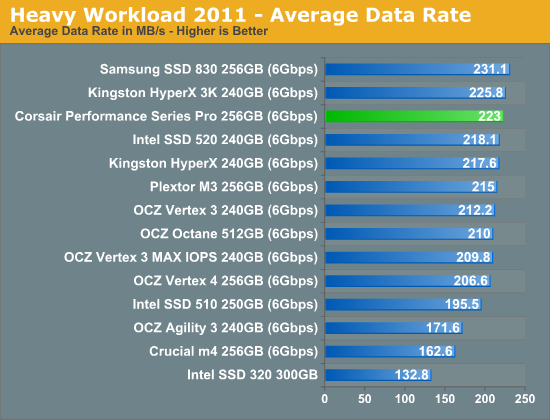
Samsung SSD 830 is still unbeatable but the Performance Pro turns out to be the fastest Marvell based SSD. It's only 3.7% faster than Plextor M3 though so the difference is not significant.
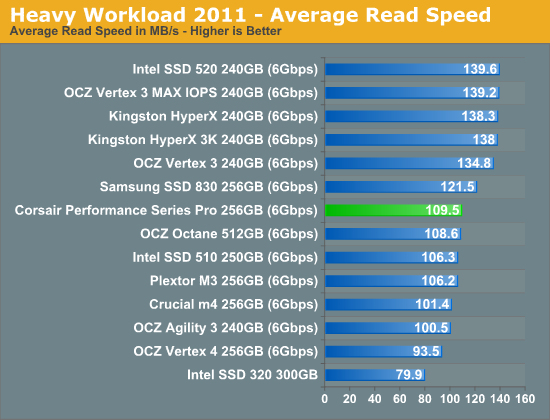

While Performance Pro was slower in sequential write performance when tested with compressible data, its outstanding incompressible sequential write speed makes it a bit faster than Plextor's M3. This is why it's always important not to look at just one benchmark when estimating the overall performance.
The next three charts just represent the same data, but in a different manner. Instead of looking at average data rate, we're looking at how long the disk was busy for during this entire test. Note that disk busy time excludes any and all idles; this is just how long the SSD was busy doing something:
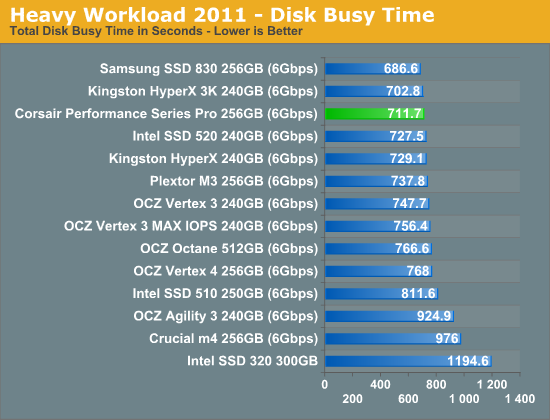
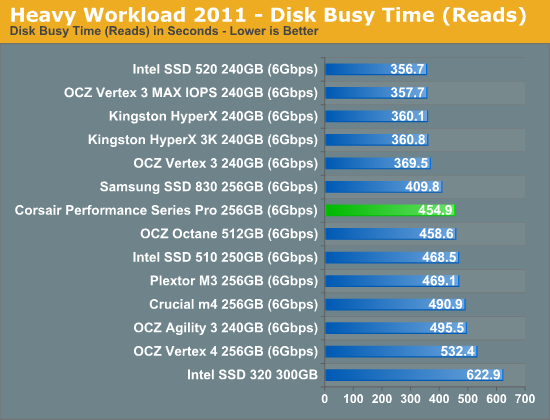
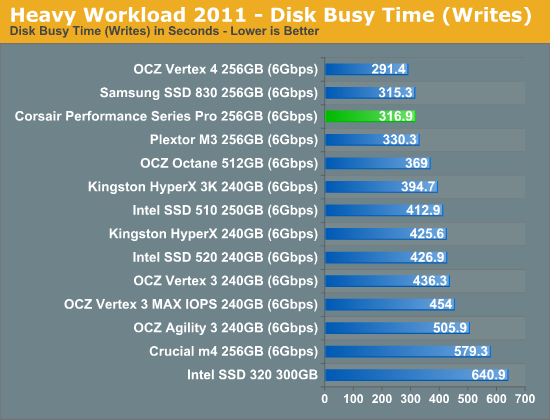










41 Comments
View All Comments
FunBunny2 - Monday, May 14, 2012 - link
-- Only Intel uses in-house firmware whereas the rest use the firmware that SandForce provides.OCZ seems to say that they do their own firmware. How to know which is which?
SilthDraeth - Monday, May 14, 2012 - link
Doesn't Samsung use their own firmware also?Operandi - Monday, May 14, 2012 - link
Samsung uses their own everything.vol7ron - Monday, May 14, 2012 - link
Can someone do a follow-up to see that those Sequential Read numbers are right for the Vertex 4?It just seems odd that the Vertex-4 bested the Vertex-3 on everything, but was significantly lower with Seq.Read
SSD_Privacy - Thursday, May 17, 2012 - link
Yes Samsung does, but does it erase your data when it says it does? The Corsair, OCZ etc.?http://www.usenix.org/event/fast11/tech/full_paper...
According to this paper SSD's are very insecure. One drive reported that the data was gone when in fact all of the data was recoverable.
Which drive was that? This paper does not tell us that. It would be very helpful if Anandtech would replicate this study and tell us which drives performed in what capacity. Much more helpful than whether drive A performed a write/read 10kb/sec faster than drive B.
appliance5000 - Friday, May 18, 2012 - link
I might be misunderstanding what's being said here, but unless you do a "secure empty trash" all that's happening when you empty the trash is that you're telling the computer that it can write over the sectors that were "emptied". The trashed data is actually still there until overwritten and thus recoverable. This is true with all drives.SSD_Privacy - Saturday, May 19, 2012 - link
SSD drives do not store data as platter drives do. An SSD drive has a controller on board that is independent of the operating system. Data is stored all over the drive at random and tracked by the controller and firmware. When you use Secure Delete Trash or Eraser on a file stored on a platter drive it will erase the data, but used on an SSD the operating system is blind to the actual location of the file.The controller removes data using its firmware "garbage collection" to prepare it for new writing. In addition, some drives have significant space that is not accessible by the user that stores and rewrites data, so if you do a full wipe none of that data will be wiped. Also some data was found to be recoverable on one drive after twenty wipes had been performed due to how the wipe was implemented by the controller on that SSD.
exallium - Monday, May 14, 2012 - link
I believe Crucial uses the Marvell controller on the M4Kristian Vättö - Monday, May 14, 2012 - link
To clarify: I was referring strictly to SandForce based SSDs. Only Intel has a custom firmware in their SandForce based 520 and 330 series SSDs - other OEMs use the firmware that SandForce provides.When we hop off the SandForce train, custom firmwares are much more common. Samsung makes everything from DRAM to firmware, Micron/Crucial uses Marvell controller but everything else is in-house, OCZ uses (possibly custom) Marvell controller in Vertex 4 but in-house firmware, and so on.
Tommyv2 - Monday, May 14, 2012 - link
How come there's no Plextor M3 Pro review, or at least including it in the charts? That's the one to beat, not the stock M3. It's supposed to be the "best of the best" of Marvell drives and AT has ignored it...